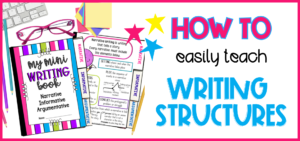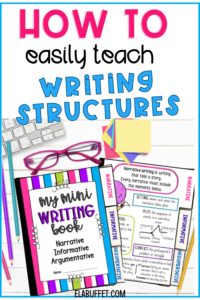If you teach writing, teaching writing structures is imperative. It doesn’t have to be hard! I’ll show you how.

Picture this—it’s test season, and you tell your kids they have to be prepared to write an essay that could be any possible genre. They have to look over notes from their bigger units on argument, narrative, AND informative writing.
Suddenly, the whining starts—fluent, unapologetic Whinese. I do NOT speak that language, and you probably don’t either.
I needed something to make their studying easier, something quick, straightforward, and dare I say… fun. Enter my trusty little writing mini-book. Cute, compact, and jam-packed with helpful info, this gem saved not only my sanity but also my students’ essays. Spoiler alert—it worked so well that now I hand it out at the beginning of the year so they can use it all year long.
And you can get it for FREE by clicking below.
Here’s the deal—understanding writing structures is vital for our little writers to succeed. But it’s also overwhelming for them. That’s why we, as ELA teachers, need to nail down strategies to make these structures stick.
For more writing tips, check out this post: Super Helpful Tips for Teaching Writing in Middle School.
Writing Structures Every Middle Schooler Should Know
The key to teaching writing structures is breaking them down so they’re digestible. Think bite-sized nuggets of knowledge, not overstuffed burritos of chaos. Whether you’re tackling argument writing, narrative structure, or informative essays, a solid foundation is critical. Here’s how I break it down for my students:
Narrative Writing Structure
Narrative writing is like building the perfect amusement park ride—it’s all about the flow. Here’s the visual I teach my students—seven steps that look like a rollercoaster:
- Exposition (The slow climb): Set the scene and introduce the characters.
- Inciting Incident (The “click-click-click” moment): Launch the story into motion.
- Conflict (Cue suspense!): What’s the big problem?
- Rising Action (Tension is building): Who doesn’t love an escalating challenge?
- Climax (Throw your hands up): The high point where it all goes down.
- Falling Action (Breathe again): Things are settling into place.
- Resolution (The end of the ride): Time to wrap things up neatly.
With this structure in mind—and maybe a few fun plotlines to practice—your students will start nailing those narrative assignments.
Argument Writing Structure
Argumentative essays are a whole different ballgame, but a structured plan makes them less daunting. Here’s what I teach my students to cover:
- Introduction: Start strong with the topic and claim. Hook your reader!
- Body Paragraphs: Present reasons and back them up with evidence. Data is power.
- Counter-Claim & Turn-Back: Address opposing ideas and shut them down with logic.
- Concluding Paragraph: Wrap it up and leave no doubt—you’ve made your case.
Pro tip? I frame this structure as their secret weapon for winning debates. Throw in some real-life examples, like convincing their parents to extend curfew, and they’re hooked.
For more on argument writing, check out this helpful post: How to Teach Argument Writing Step-by-Step
Informative Writing Structure
Informative writing is all about, well, informing (shocking, right?). I teach this with different formats for different tasks:
- Lead/Hook (Grab attention): Start with an interesting fact, question, or story.
- Background Information (Set the stage): Provide context so readers understand the topic.
- Thesis Statement (The main point): Clearly state what the essay will cover.
- Body Paragraphs (Choose your structure): Is this sequence? Problem and solution? Cause and effect? Maybe compare and contrast? Each essay’s — or paragraph’s– purpose will determine the structure.
- Wrap it Up (Mic drop): Conclude with a summary of what readers should take away.
Once I break down each structure, I have my kids practice identifying which structure to use for different topics. The lightbulb moments? Priceless.
The Secret to Making Writing Structures Stick
Here’s the thing—teaching these concepts once and expecting them to stick forever is like expecting a kid to clean their room without being asked twice. It’s not happening. Repetition, reminders, and references are the name of the game.
That’s where my trusty writing mini-book comes in. It’s a simple, foldable guide that students can keep tucked into their notebooks for easy reference. Each page breaks down a different writing structure, complete with visuals and examples. Think of it as their writing GPS—perfect for navigating any daunting assignment.
When I first introduced the mini-book, my students treated it like a novelty. “It’s so cute, Ms.B.!” they’d say as they assembled them. But weeks later, I’d catch them flipping through their books quietly before starting an essay. And during our prep for the final exam? Not one single “Where does a thesis statement go again?”
The mini-book did its job.
Why This Matters
Teaching writing structures isn’t just about passing exams or meeting standards—it’s about equipping students with lifelong communication skills. These structures give them the confidence to express themselves clearly, whether they’re crafting essays, presenting arguments, or sharing narratives.
Without these tools, writing can feel like wandering through a maze blindfolded. But with them? Writers—yes, even fifth graders—can tackle any genre with clarity, purpose, and maybe even a little joy.
Want to Make This Easy?
If you’re ready to help your students master writing structures while keeping your own sanity intact, grab a copy of my writing mini-book. Your kids will love it, and you’ll love how much smoother writing assignments become.
[Click here to grab your copy now!]
Trust me—this little booklet might just become your secret weapon for writing success.
Get it by clicking here.





